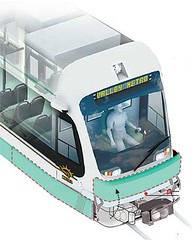Learning from system failures
 Valley Metro Rail has designed unique safety features into its light rail trains. Image source: Valley Metro.
Valley Metro Rail has designed unique safety features into its light rail trains. Image source: Valley Metro.The Arizona Republic, in "Valley Metro learns from others' light-rail failures," reports on the Phoenix-area light rail system's plans for reducing collisions where the light rail system runs in-street along with cars. From the article:
When light-rail trains roll through busy Valley streets, transit officials hope they run more like those in Salt Lake City than Houston.In Houston, a catalog of 62 collisions over two years, causing 110 injuries and a death, led critics to call the train the "Wham Bam Tram."In Salt Lake City, which, like Houston, has seven miles of in-street track, crashes totaled eight in the same period. Four a year is the national average.
In planning its system, Valley Metro is spending extra time, money and attention on safety, saying a lot is at stake: people's lives, the perception of light rail, and money in damage settlements.
Metro engineers traveled to several cities to borrow safety ideas. What emerged were streets designed to separate cars from trains; traffic and pedestrian signals timed to minimize collisions; uniquely engineered rail cars; and plans for a public safety education blitz."It's the synthesis of a lot of good ideas in the industry," Metro operations chief Joe Marie said.
Given our car-centric society, and the fact that automobile drivers aren't accustomed to sharing the road with anybody else, and even increasingly, other cars, it makes sense to design in-street rail in a manner that expects drivers to be fools.
A couple decades ago, I remember reading about a University of Chicago student in the middle of an intersection, standing on a sidewalk island, seemingly safe, and a car hit and killed her. Then I realized it wasn't about me following the law, but the expectation of others being fools (kind of a flipside of my "design for maintenance" philosophy).
Index Keywords: transit



0 Comments:
Post a Comment
<< Home